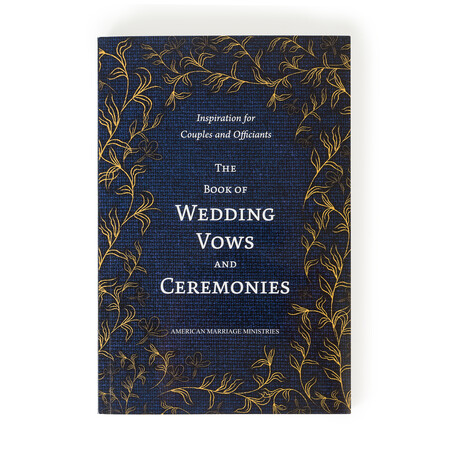1. The Procession
The procession, or processional, marks the formal start of the wedding. This is the part of the ceremony when the wedding party enters. The processional sets the tone and energy for the wedding ceremony. The music, pace, order and members of the procession convey mood, whether it's solemn and traditional or joyful and celebratory.
The procession provides a way to recognize and honor people involved in the wedding, such as parents, grandparents, siblings, and members of the bridal party. Folks chosen to participate in the procession are a reflection of the couple and their community. This part of the ceremony lets loved ones witness and celebrate the couple's union as they make their formal entrance.
Learn More
2. The Invocation
The invocation is the part of the ceremony where the officiant greets the guests, introduces the couple, announces the purpose of the gathering, and shares a few words on marriage. This part of the ceremony announces the formal beginning.
The wedding invocation is the opening prayer, blessing, or speech that marks the formal beginning of the wedding ceremony. If guests were clapping and cheering during the entrance, this is a great time to dial it in and focus on the couple.
The invocation can vary depending on the beliefs and traditions of the couple. The officiant may include words of gratitude for the love and commitment shared by the couple, expressions of hope for their future together, and requests for guidance, protection, and good fortune.
For less formal weddings, this part of the ceremony can also be humorous. Some couples want to focus on what brings them joy, and they want to share that with their guests. Our officiants have quoted movies, told funny stories, and made guests laugh just as often as cry during this part.
That said, the invocation sets the tone for the ceremony, conveying a sense of reverence and significance as the couple and their loved ones gather to witness and celebrate their union. It serves as a moment of reflection and connection, inviting guests to share their support with the couple as they begin their married life together.
Also, don't forget to tell the audience to be seated if they stood during the bride's entrance. This might also be a good time to tell them to silence their cellphones!
Learn More
3. The Declaration of Intent
During the declaration of intent, the couple publicly declares their intent to marry. In some states, this part of the ceremony is mandatory. Even if it is not required (check to see if it is in your state) most guests expect it, and it's a good idea to include it.
The declaration of intent usually takes on three kinds of significance: legal, symbolic, and public. In some jurisdictions, the law requires the couple to say some form of “I do…” in order for the wedding to be considered valid. There are plenty of ways for the couple to affirm their desire to marry each other, with the officiant and the guests as witness.
Beyond its legal significance, the declaration is a symbolic moment. It is a verbalization of the couple's commitment to each other, their willingness to share their lives and futures together, and their promise to honor the agreements they are about to enter into.
Finally, by making their intentions known publicly, loved ones witness and support the couples commitment to each other. This public statement can be a powerful and emotional moment, both for the couple and for their guests.
Learn More
4. The Vows Exchange
The vow exchange is one of the most memorable and unique parts of a wedding ceremony, where couples exchange their words of commitment. Sometimes it's in the form of a poem or verse, sometimes it's something that they have written, sometimes it's done using the “repeat after me” format.
There are lots of ways to accomplish this and the decision should be based on the couple's comfort with public speaking, what they want to say, and the nature of the ceremony.
The vow exchange is a great way for the couple to express why they are marrying their partner, and what marriage means to them. For these words to really resonate, it's important that the couple is given space and guidance to find their voice. The officiant's role is to coach them, ask them the right questions, and lead them towards a short declaration that feels authentic and powerful.
Learn More
5. The Rings Exchange
This is the part of the ceremony when the couple exchanges their rings. Since rings are a physical symbol of marriage and unity, this part of the ceremony lets the couple make a commitment by putting rings on each other's fingers in a symbolic binding action.
The wedding rings symbolize the couple's unbroken commitment to each other. By exchanging rings, they are expressing their love, devotion, and lifelong dedication to their marriage. Rings are made in a circular shape. This shape represents infinity and eternity. As they wear their rings, the couple make a statement about love having no beginning or end.
Wedding rings are also a tangible sign of the couple's married status. The exchange of rings often accompanies the recitation of vows, and can even be merged with the vow exchange (see above).
The tradition of exchanging rings has been practiced for centuries in cultures around the world. The rings represent continuity with the shared customs and values of the couple's community.
Overall, the ring exchange is a powerful, and recognizable moment in the wedding ceremony, marking the couple's transition to married spouses.
Learn More
6. The Pronouncement
This pronouncement is the part of the ceremony where the couple is declared to be married, and is undertaken by the officiant. That's the "By the power vested in me by…" part. This is a part of the ceremony where the officiant really steps into their role, and is empowered to declare the contract of marriage to be valid and in effect.
This is usually one of the last parts of the wedding ceremony. It's an indication to guests that the wedding ceremony is coming to a close. This section will teach you the specific words that guests expect to hear, since there really is a formula that folks expect.
Following the pronouncement, the couple often seals their marriage with a kiss. That's the “you may now kiss each other…” part. Once again, don't make any assumptions, since some couples may not be comfortable with public displays of affection, and may want to try something different. We've seen officiants say, “Let's show the newlyweds our support,” while everyone claps and cheers. This way, the couple is free to kiss, embrace, or raise their clasped hands in triumph – whatever happy display of affection they choose.
Learn More
7. The Recession
The recession marks the end of the ceremony, and everyone exits the room. But for the officiant, leading this part of the ceremony is important. It lets you tell guests what's next, and set the tone and action for the remainder of the day. Make sure to plan this part out, and don't just wing it.
Generally, the couple will leave first together. Next the bridal party, and then the family will make their exit. The officiant should be the last person to leave, unless otherwise specified. It's important to review this order in advance, since you don't want an awesomely choreographed wedding ceremony to devolve in confusion in the last few minutes.
Learn More
That's all there is to a basic wedding ceremony. Check out our Wedding Ceremony Template page to see how all these pieces fit together to form a complete wedding ceremony.
The information provided on these pages covers a basic wedding ceremony format. Many weddings include other parts, such as a sand ceremony, candle lighting, etc. that are not described on these pages.





